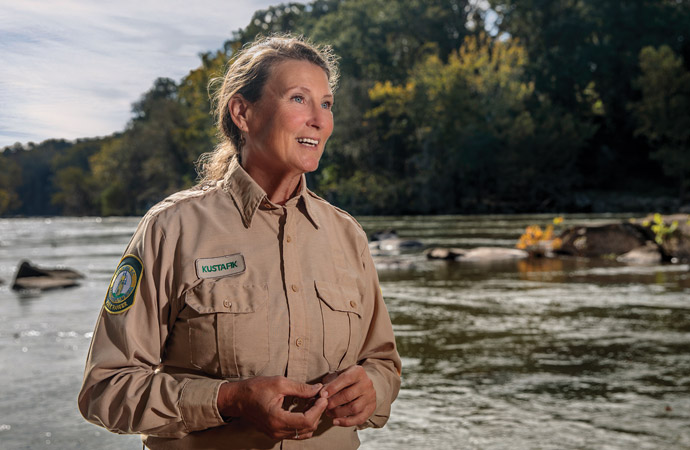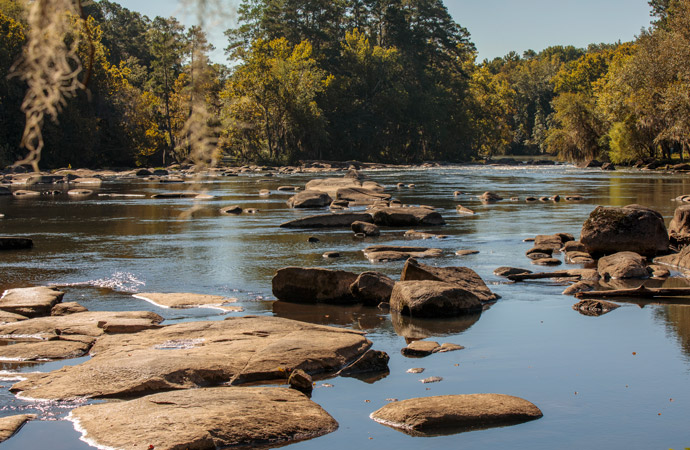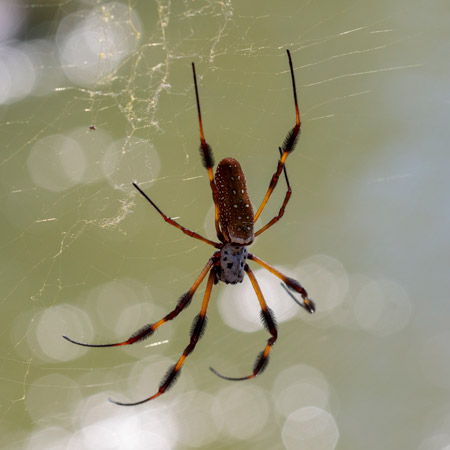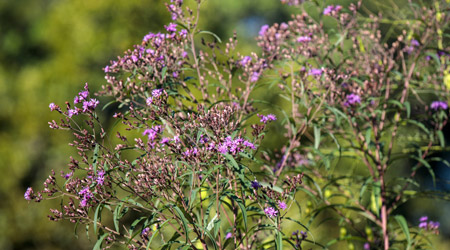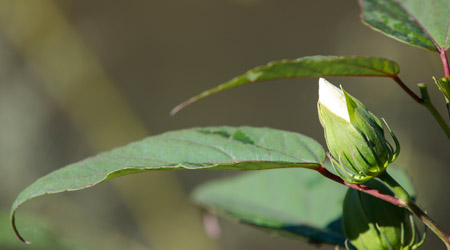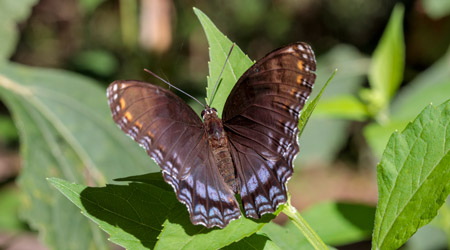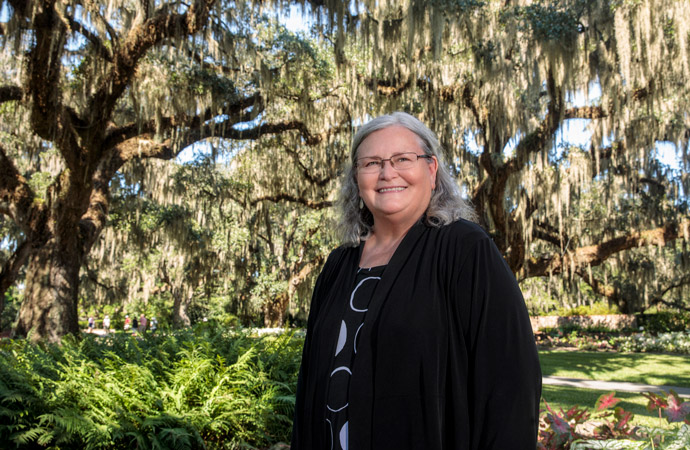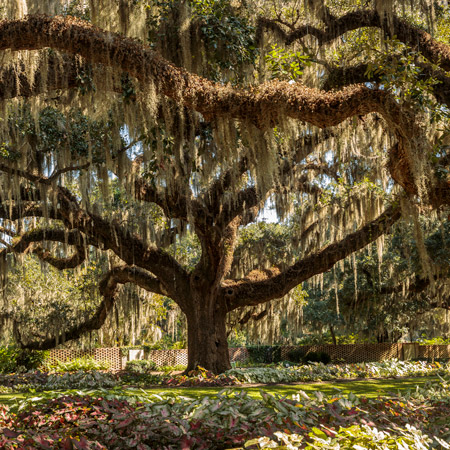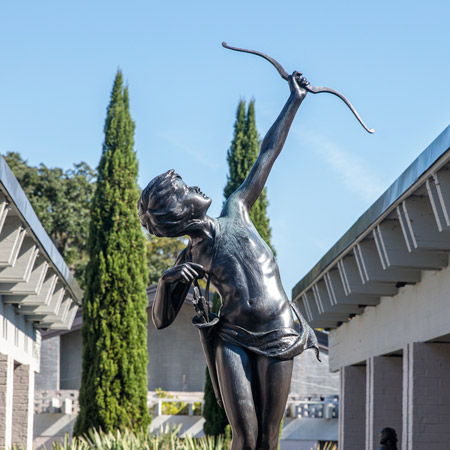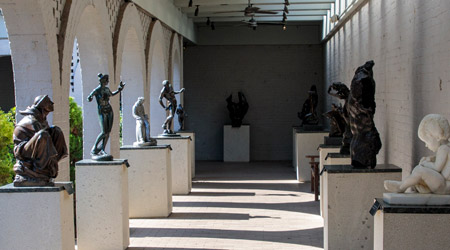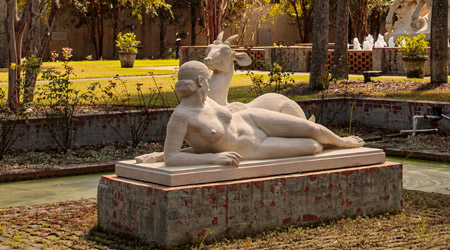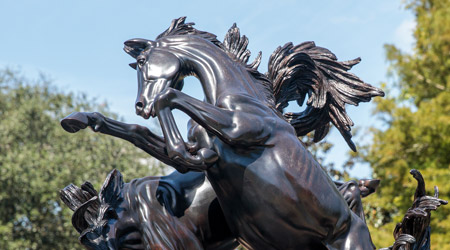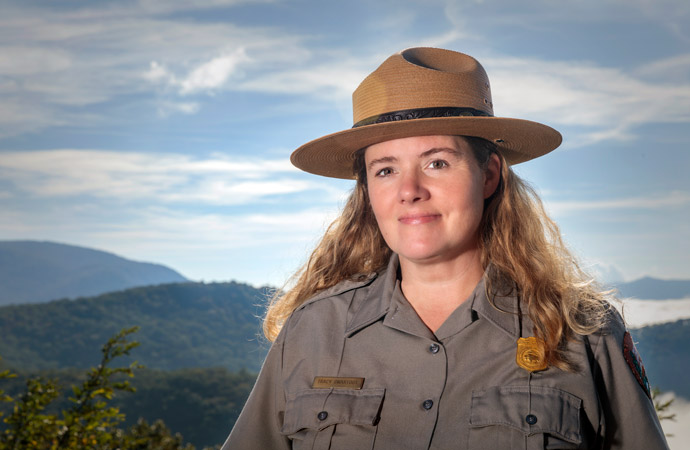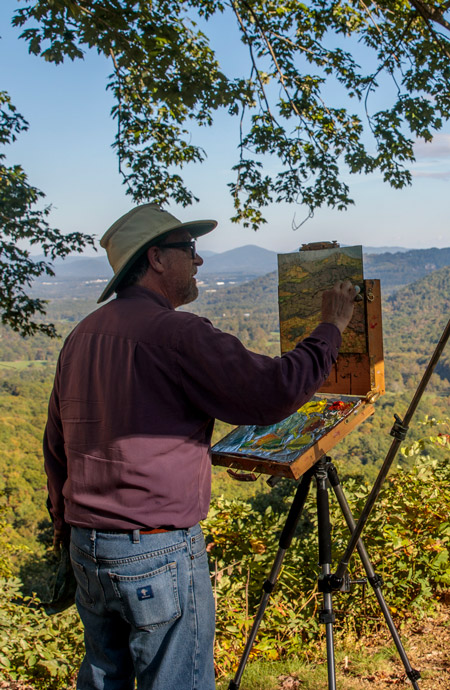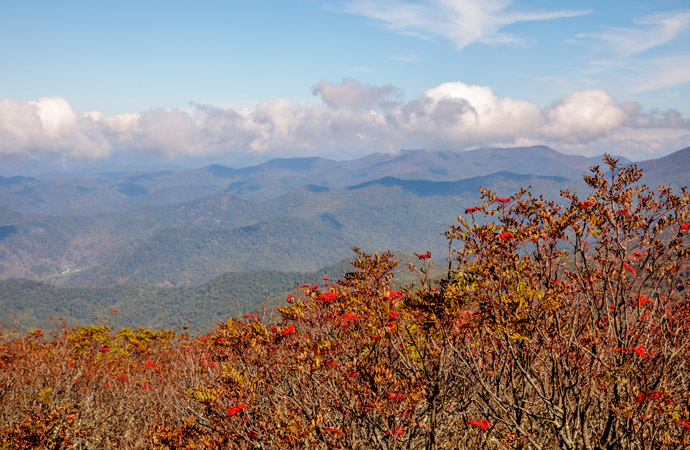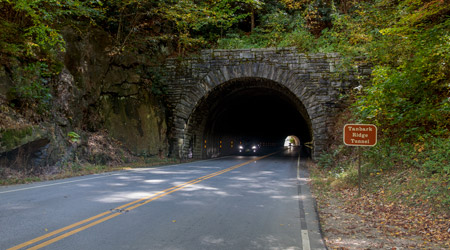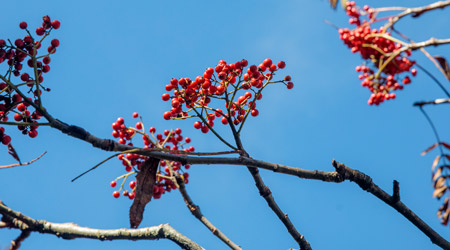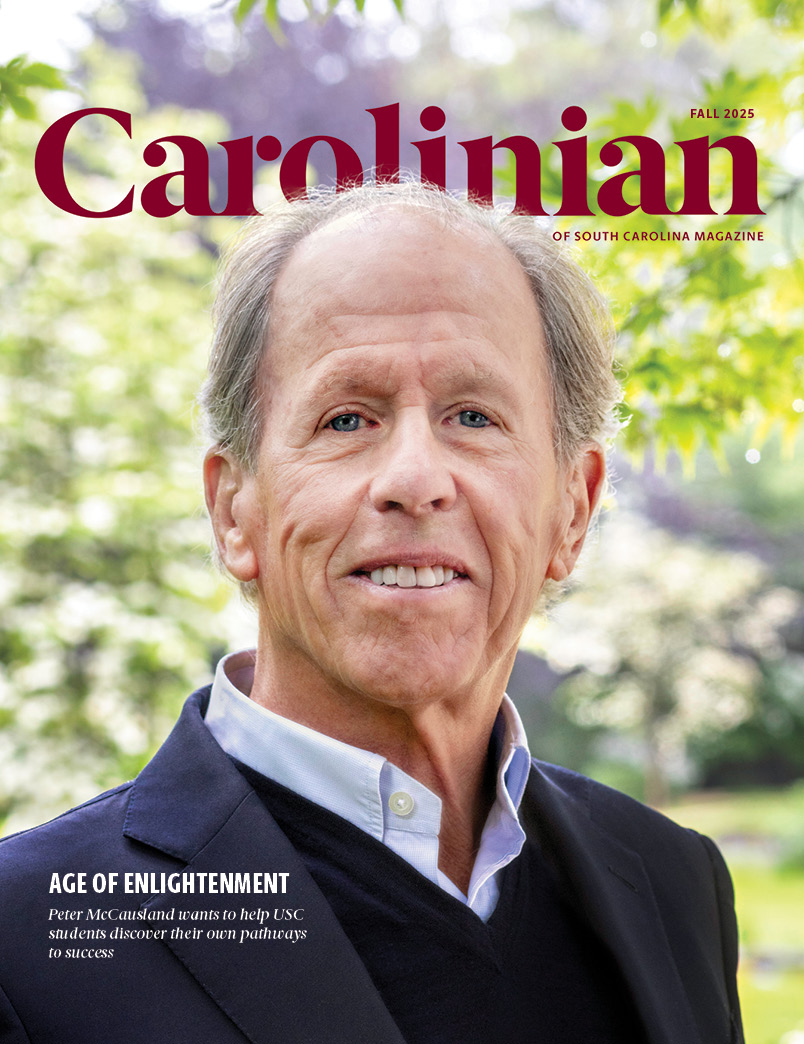Out and About
For some alums, a day at the office is a walk in the park
Need a break from the daily grind? A mental reset? A breath of fresh air? There’s
an easy fix, and it’s as simple as getting outdoors. Take a walk through a riverfront
park, a stroll through a sculpture garden or a drive down a scenic highway with the
windows down, stopping at every scenic overlook to take in the view — you can’t help
but feel at least a little bit better. Just ask Robin Salmon, Karen Kustafik and Tracy
Swartout, three dynamic alumni featured in the winter 2022 issue of Carolinian magazine and celebrated below. They help make these getaways possible for the rest
of us, but they’re also living proof of the benefits that come from getting out and
about.
Meet our Alumni
As assistant superintendent for environmental services for City of Columbia Parks and Recreation, Karen Kustafik, ’05, supervises park rangers throughout the city. If one park speaks most to her own story, though, it’s the Saluda Riverwalk, a 3.1 mile stretch of riverside trail between the I-26 flyover and the confluence of the Lower Saluda and Broad Rivers at Boyd Island.
The newest segment of the expansive Three Rivers Greenway, the Saluda Riverwalk opened to the public in 2021, but Kustafik’s appreciation for the riparian landscape predates her job with the city.
“I originally got interested in the rivers through advocacy,” she says. “I was involved with Palmetto Paddlers and the whitewater community. The people who use these rivers are very passionate, they feel ownership of the rivers.”
Kustafik included. A Pennsylvania native, she fell for the wild Southern landscape, particularly the rivers, after her family relocated to Winnsboro for her ex-husband’s job. “It was the most wonderful culture shock,” she says. She got into kayaking as something to do with her 10-year-old son.
“When I started, I was terrible, I couldn’t roll my kayak for months,” she recalls. “I got passed from one mentor-instructor to another. I’d come back from a river trip bruised and battered, but I just loved it. I was having so much fun.”
She was also getting an education. After years in the hospitality industry —in her past life she was bar manager at the Capital City Club — Kustafik was contemplating her next move when the river showed the way. Her particular epiphany happened one late summer evening at the Millrace Rapids, kayaking just above Riverbanks Zoo.
“I eddied out at sunset, I had made it partway through, when this impossible light appeared. It gilded everything, almost like a Maxfield Parrish painting, just crazy beautiful,” she says. “At the same time, the river’s rushing around me, then a train goes by and blows the horn, so there’s this big cacophony. It was intense. But this God-light was coming down, and I just thought, OK, I’ve got this — I’ll go from here to here to here. Anything is possible if you break it down into eddies, one move to the next.”
The next morning Kustafik decided to enroll at Midlands Tech with the goal of transferring to the university, which she did. She ultimately graduated from USC with a degree in interdisciplinary studies — specifically, environmental studies and marketing/public relations. “And that wound up being absolutely right for what I do,” she says.
Apart from a six-year stint with the city’s Stormwater Management Team, Kustafik has been with City of Columbia Parks since college, and even during the hiatus she enjoyed showing off the river as a kayaking instructor in the university’s Outdoor Recreation program. She ultimately gave up the side gig when she returned to Parks and Recreation, but her commitment to community education is a constant, whether she’s pointing out a bald eagle’s nest, praising pollinators, namechecking flowers and/or extolling the beauty of the delicate-but-tenacious spider lilies that bloom along the Midlands rivers in the late spring and early summer.
“The best days are helping other people have epiphanies, getting out there and showing someone something that they didn’t know before,” Kustafik says. “I get to do neat stuff. I get to show people our best places.”
-
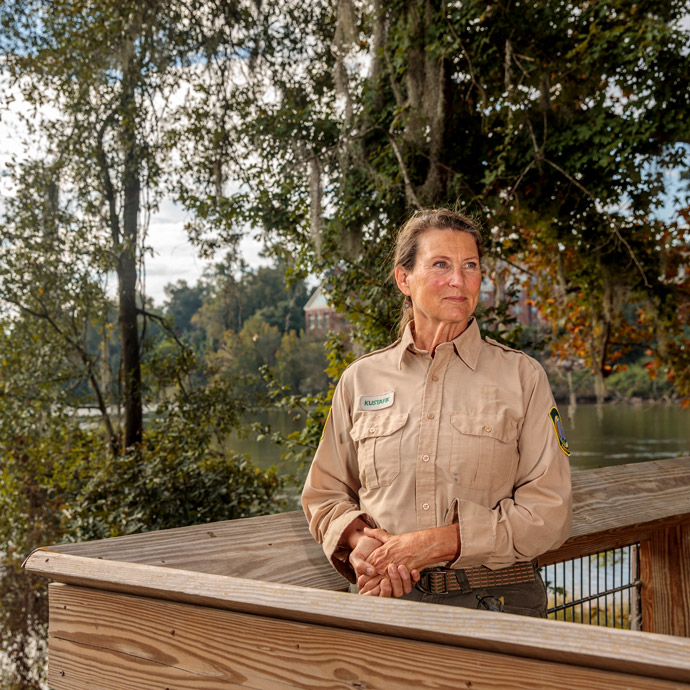
-
The best days are helping other people have epiphanies, getting out there and showing someone something that they didn’t know before. I get to do neat stuff. I get to show people our best places.
Karen Kustafik, ’05
When alumna Robin Salmon, ’73, joined the staff at Brookgreen Gardens she was two years out of college and new to the Grand Strand. After a couple years at an office job in Columbia, she had followed her husband to Georgetown but landing a job there wasn’t easy for the young history major, art minor, and she soon found herself throwing a Hail Mary.
“I was actually training to be a waitress at the brand-new Pizza Hut when I decided to cold call the president of the Georgetown County Historical Society, Glennie Tarbox — maybe they would have a part-time job,” she recalls.
As it turned out, the historical society was pretty much a volunteer operation, but Salmon’s initiative didn’t go unnoticed. Tarbox referred her to his cousin, Gurdon Tarbox, who was Brookgreen’s executive director.
It wasn’t exactly what Salmon trained for during two and a half years as a student assistant at South Caroliniana Library, but working at one of the nation’s premier public gardens offered its own perks — a live oak allée draped in Spanish moss, a dizzying array of seasonal flora and, of course, acre upon acre of sculpture by some of the most notable figurative sculptors in American history.
“I cold called and fell into this marvelous opportunity, but I didn’t get a job because of my history and art degrees,” Salmon says with a laugh. “I got it because I could type!”
Nearly 47 years later, Salmon is Brookgreen Gardens’ vice president for art and history collections and curator of sculpture, and she uses her USC education every day. Her primary responsibilities include new acquisitions, conservation and educational programs, and she can stop beside any of the nearly 3,000 sculptures and tell you something interesting about the artist and their work.
But her knowledge isn’t limited to the marble and granite, aluminum and bronze. Salmon knows pretty much the entire 9,100-acre property by heart. “I learned Brookgreen from the inside out,” she says. “I did payroll, I paid bills, I sent out materials to new members, I worked at the information desk and in the ticket booth. I joke that I’ve done everything at Brookgreen except pull weeds and feed animals in the zoo.”
Salmon has also written or edited multiple books on Brookgreen, including three pictorial histories and two catalogs, plus a new collection of lectures called Brookgreen 101: A Curator’s Legacy. Her next book, though, is particularly special to her — a biography of Anna Hyatt Huntington, the renowned sculptor and philanthropist who opened Brookgreen Gardens with her husband, Archer Huntington, in 1932.
“I’ve never felt like I needed to go someplace else to be challenged,” she says. “I’ve been at Brookgreen Gardens for over half its history, but I’m still learning. Our slogan is ‘ever changing, simply amazing,’ and that’s not for nothing. It’s very true.”
-
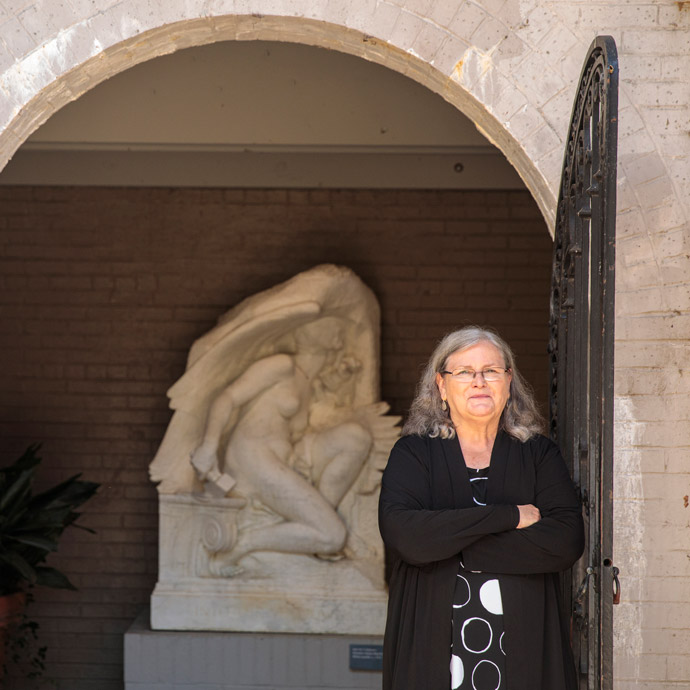
-
I’ve been at Brookgreen Gardens for over half its history, but I’m still learning. Our slogan is ‘ever changing, simply amazing,’ and that’s not for nothing. It’s very true.
Robin Salmon, ’73
For the 14 million tourists who visit every year, the Blue Ridge Parkway offers a leisurely joyride through nature. For University of South Carolina geography alumna Tracy Swartout, ’95, who became the national park’s first female superintendent in May, it’s more like a homecoming.
For eight-and-half years, Swartout was deputy superintendent at Mount Rainier National Park in Washington. But the Columbia, South Carolina, native began her National Park Service career at Congaree National Park, outside Columbia, and she has been a regular visitor to the scenic 469-mile Blue Ridge Parkway her whole life.
It was a favorite road trip for her family when she was a child, and before she transferred to the University of South Carolina as a sophomore, she spent a couple of semesters at Montreat College, in Black Mountain, North Carolina, not far from the parkway’s Asheville headquarters. It became a go-to destination for outdoor recreation for her and her friends.
“Even when I went to USC, I'd go backpacking and I'd go rock climbing with friends from Columbia and we'd use the parkway — we'd go over to the Smokies, we’d go to Pisgah,” she explains. “Even when I went away to grad school in Canada and I brought Canadian friends home with me, we drove the parkway. It's sort of always been a touchstone in my life.”
And now it’s Swartout’s job to help bring that unique parkway experience to future park guests, which means recognizing the challenges but embracing the opportunities presented by its distinctive topography, history, design and function.
“It's a historic infrastructure park,” she explains. “We're really preserving that experience of getting on the road, winding through that beautiful landscape, stopping along the way and having these experiences where you kind of go into the resource — you're going onto an overlook, you're looking out at a historic home.”
It’s also a complicated dynamic to manage. Because the parkway’s viewshed extends beyond the boundaries of the park itself, Swartout has to weigh the interests of stakeholders in 29 counties, over two states, from the southern terminus of the Shenandoah National Park in Virginia to the edge of the Great Smoky Mountain National Park near Cherokee, North Carolina.
In that respect, the Blue Ridge Parkway differs significantly from “single-gate” national parks such as Congaree National Park, where she cut her teeth.
“We don't have just one point of entry [at the Blue Ridge Parkway]. We have many, many, many points of entry,” she says. “And that presents us with really interesting opportunities but also special challenges. People often want to add more connections to the parkway, because they want to connect their community to the experience we provide, and yet one of the things that we're trying to ensure, protect and preserve is that experience.”
There’s more to the job than most visitors may realize — and more to the park itself. There’s the natural landscape and the roadway that winds through it, but there’s also the infrastructure and services that undergird all that scenic mountain beauty: water treatment plants, power lines, service roads, EMS services — even a police force.
“I think people grow up with this idea of what national parks are or what a park ranger is — you know, the iconic flat hat, the guided programs,” she says. “It is that, but it’s also like managing a small municipality.”
And then there are those aspects of the 85-year-old park’s manmade infrastructure that are as beautiful as they are functional, and that are as much a part of the visitor’s experience as the landscape.
“Thanks to the work of landscape architects and multiple New Deal era programs of the 1930s and 1940s, the roads and bridges were designed to be part of the visitor’s experience, it's really an opportunity to see some amazing feats of civil engineering,” Swartout says. “There are places where they laid the road delicately upon the land and allowed for the road to create the experience.”
While parkway construction began in the 1930s, she also cites modern engineering marvels such as Linn Cove Viaduct, a seven-mile stretch alongside Grandfather Mountain completed in 1987 after decades of study and debate. Once considered the parkway’s “missing link,” it is now a top destination — and proof that improvements can always be made, even at one of the most popular national parks in the country.
For Swartout, now in her twenty-first year with the National Park Service, it’s a reminder of what drew her to the profession in the first place — when an undergraduate class taught by South Carolina geography professor Bob Janiskee revealed the complexities of the park system and the work that goes into maintaining, improving and sharing its wonders with the public.
“I love my job more now than I did the day I started, and I loved it when I started,” she reflects. “It is everything I thought it would be and so much more.”
-
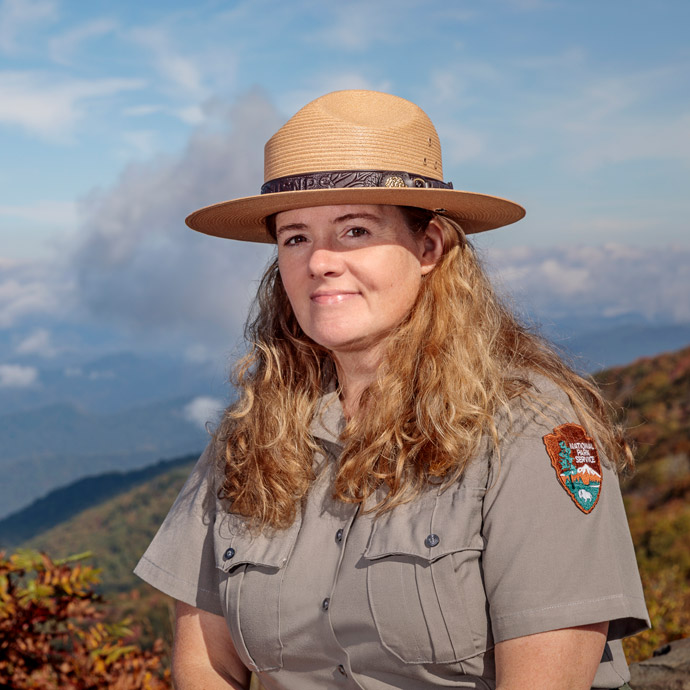
-
I think people grow up with this idea of what national parks are or what a park ranger is — you know, the iconic flat hat, the guided programs. It is that, but it’s also like managing a small municipality.”
Tracy Swartout, ’95
